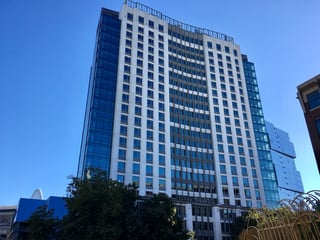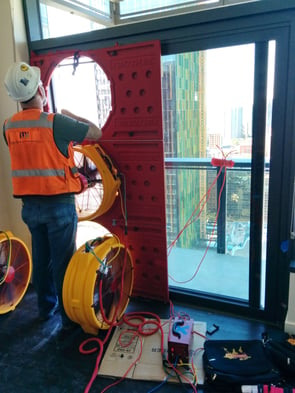Seattle Energy Code: How will 2018 updates affect your next project?
The Seattle Energy Code is one of the more stringent codes in the country, and continues down that path with its 2018 revisions.
With building energy-use in mind, there are specific provisions for the Building Envelope that can have a big impact on your project.
Glazing Ratios

Under the prescriptive compliance path, a building can have a maximum of ratio of vision (clear) glass to opaque wall of 30%. There are a few exceptions:
-
The design can include up to 40% glazing if there are daylighting controls and as long as at least 25% of that glazing is within a daylight zone for buildings above 3 stories.
-
If there is more than 45% vision glass, the project will require an additional 0.33% energy savings per each percentage point above 45% of the window-to-wall ratio.
-
If the design includes skylights, the glazed portion can occupy a maximum of 5% of the overall roof area.
-
Street level retail glazing can be excluded from the vision glass limitations, however, it cannot be included in trade-off calculations.
In summary, the code continues to drive reduced energy use – so understanding the fine print is critical when looking to maximize vision glass.
High Performance Heating Clause
A clause coming into effect January 1, 2018 may have a significant impact on your window selection. If your project uses a fossil fuel energy source or electric resistance heating, the building’s design must make up for it with a higher performing building envelope, specifically with high-efficiency window systems.
These energy sources will require window systems that might need to include a mix of double or triple-glazing, or high-performance vinyl or fiberglass framed units depending on the overall fenestration area. In order to avoid these higher window requirements, the project must use high performance heating such as heat pumps or variable-refrigerant flow systems.
Existing Buildings – Substantial Alterations Clause
Existing conditions, construction value or extent of renovations are typical reasons a project may have to comply with this clause. Early signs that this clause may apply include:
-
Changes to glazing beyond a simple
 repair/replacement.
repair/replacement. -
Significant mechanical upgrades or full lighting replacements, depending on the value of the project.
-
Re-occupying a building that has been empty for more than 2 years.
- Changes that substantially extend the useful life of the building.
If this clause is triggered, other building systems that are not part of the project, may also have to be upgraded. There are exceptions in the code, so be sure to check with your code consultant.
Not new to the code, but still important to remember…
-
Whole Building Air Leakage Testing is mandatory and applies to all code compliance paths. The code outlines a passing rate of 0.3 cfm/square foot. If a building does not pass, efforts to reduce the air leakage must be made, documented and submitted to the City Code Official.
-
Emphasis on reducing thermal bridging and the use of continuous insulation. Thermal bridging can cause considerable energy loss – proper detailing at system transitions and the use of continuous insulation greatly improves the thermal performance, keeping occupants comfortable and preventing the mechanical systems from overwork (which will also help with your energy bill!)
Have questions?
Do you have questions about the energy code and how it will affect your next project? Feel free to reach out to our team. We’d love to chat with you.
Not in Seattle? If you happen to be in British Columbia, check out our post about the new BC Step Code and how to build beyond compliance. Keep an eye out for the last blog post in our code series about the new Toronto Green Standard.
This post was revised on January 31, 2018.
Posts by Topic
Topics
- 5G (1)
- ACEC (3)
- Active Transportation (5)
- AFP/P3 (6)
- Alberta (5)
- Anniversary (1)
- approvals (1)
- Architect (2)
- Atlanta (2)
- Awards (62)
- Biophysical Sciences (1)
- Board of Directors (1)
- Bridge Rehabilitation (3)
- Building and Facilities Engineering (2)
- Building Energy (25)
- Building Envelope (48)
- Building Science (65)
- Calgary (2)
- Canada 150 (1)
- Canstruction (2)
- Capabilities (1)
- Carbon emissions (2)
- Carbon Pathfinder Tool (1)
- Carson Awards (5)
- Charity (13)
- Climate Adaption (7)
- climate change (7)
- Code and Life Safety (8)
- Commercial Buildings (4)
- Commissioning (11)
- Construction (2)
- Construction Administration (5)
- Consulting Engineering (1)
- Critical Facilities (33)
- CSR (24)
- Culture (5)
- Dallas (1)
- Data Center (22)
- Data Center Commissioning (9)
- Data Center Design (12)
- design (9)
- Design Build (1)
- DSSP (1)
- edgecomputing (1)
- edgetechnologies (1)
- Edmonton (4)
- Electrical (24)
- Electrical engineering (8)
- Energy (8)
- Engineers Canada (5)
- Environmental (36)
- Environmental Compensation (1)
- Environmental Impact Assessment (3)
- environmental planner (3)
- Environmental Planning (5)
- ETFE (1)
- Event (12)
- Existing Buildings (6)
- Facade Engineering (4)
- Ferry Docks (2)
- FIDIC (3)
- fisheries biologist (1)
- Flood Mapping (1)
- Florida (1)
- Forensic Investigation (1)
- Fundraising (11)
- garage (2)
- Gender Diversity (8)
- Gender Intelligence (3)
- Geometric Design (2)
- Government (14)
- Hospitality (1)
- Houston (4)
- Hydro (2)
- India (1)
- industrial (4)
- Infrastructure (28)
- Innovation (1)
- interchange (1)
- IWD (2)
- IWD2021 (1)
- Land Development (8)
- Landfill (4)
- Manitoba (1)
- MCF (3)
- Mechanical (21)
- Mechanical Engineering (1)
- MEP (1)
- mission critical (10)
- Moncton (1)
- Motivational MH'er (1)
- Multi-Use Pathways (1)
- Municipal Infrastructure (5)
- municipal solid waste (2)
- MUP (1)
- New Brunswick (1)
- New Hire (17)
- New Role (3)
- Newsroom (121)
- northern communities (2)
- NVTC (2)
- ontario (1)
- Operations Consulting (8)
- Ottawa (2)
- Panel (3)
- People (124)
- Project Management (6)
- QAP (1)
- Rail (1)
- Reconstruction (1)
- regulatory (1)
- Renewable Energy (2)
- resiliency (3)
- Risk Management (1)
- Roads and Highways (3)
- Salt Lake City (1)
- Seattle (1)
- Security (4)
- Social Responsibility (30)
- Solid Waste (11)
- solid waste management (5)
- St Johns (2)
- Stantec (1)
- Structural (14)
- Sustainability (23)
- Telecom (9)
- Texas (1)
- Toronto (13)
- towers (1)
- Traffic Assessment (2)
- Transfer Station (1)
- Transit (13)
- Transit Consultant (3)
- Transit Infrastructure (3)
- Transit Planning (2)
- Transportation (30)
- Transportation Engineering (8)
- transportation structures (2)
- TTC (1)
- Vancouver (6)
- Virginia (2)
- Washington DC (3)
- Waste to Energy (2)
- Water & Wastewater (8)
- Water Resources (3)
- wellfield (1)
- wellness challenge (1)
- Whistler (1)
- Whitehorse (1)
- Wireless (2)
- Women in Engineering (5)
- Yukon (5)
